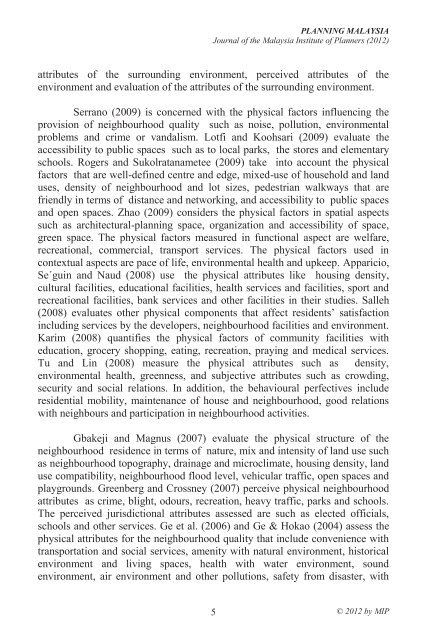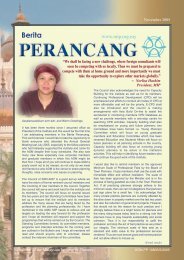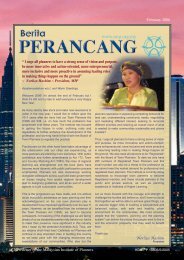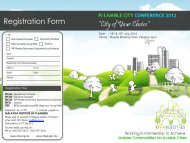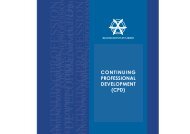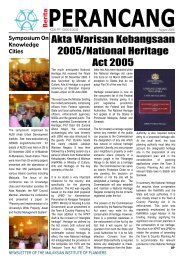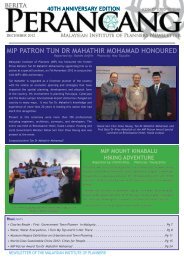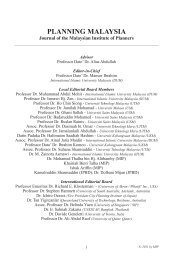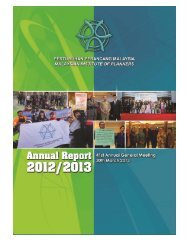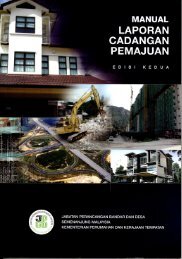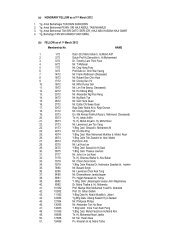Untitled - Malaysian Institute of Planners
Untitled - Malaysian Institute of Planners
Untitled - Malaysian Institute of Planners
Create successful ePaper yourself
Turn your PDF publications into a flip-book with our unique Google optimized e-Paper software.
PLANNING MALAYSIAJournal <strong>of</strong> the Malaysia <strong>Institute</strong> <strong>of</strong> <strong>Planners</strong> (2012)attributes <strong>of</strong> the surrounding environment, perceived attributes <strong>of</strong> theenvironment and evaluation <strong>of</strong> the attributes <strong>of</strong> the surrounding environment.Serrano (2009) is concerned with the physical factors influencing theprovision <strong>of</strong> neighbourhood quality such as noise, pollution, environmentalproblems and crime or vandalism. Lotfi and Koohsari (2009) evaluate theaccessibility to public spaces such as to local parks, the stores and elementaryschools. Rogers and Sukolratanametee (2009) take into account the physicalfactors that are well-defined centre and edge, mixed-use <strong>of</strong> household and landuses, density <strong>of</strong> neighbourhood and lot sizes, pedestrian walkways that arefriendly in terms <strong>of</strong> distance and networking, and accessibility to public spacesand open spaces. Zhao (2009) considers the physical factors in spatial aspectssuch as architectural-planning space, organization and accessibility <strong>of</strong> space,green space. The physical factors measured in functional aspect are welfare,recreational, commercial, transport services. The physical factors used incontextual aspects are pace <strong>of</strong> life, environmental health and upkeep. Apparicio,Se´guin and Naud (2008) use the physical attributes like housing density,cultural facilities, educational facilities, health services and facilities, sport andrecreational facilities, bank services and other facilities in their studies. Salleh(2008) evaluates other physical components that affect residents’ satisfactionincluding services by the developers, neighbourhood facilities and environment.Karim (2008) quantifies the physical factors <strong>of</strong> community facilities witheducation, grocery shopping, eating, recreation, praying and medical services.Tu and Lin (2008) measure the physical attributes such as density,environmental health, greenness, and subjective attributes such as crowding,security and social relations. In addition, the behavioural perfectives includeresidential mobility, maintenance <strong>of</strong> house and neighbourhood, good relationswith neighbours and participation in neighbourhood activities.Gbakeji and Magnus (2007) evaluate the physical structure <strong>of</strong> theneighbourhood residence in terms <strong>of</strong> nature, mix and intensity <strong>of</strong> land use suchas neighbourhood topography, drainage and microclimate, housing density, landuse compatibility, neighbourhood flood level, vehicular traffic, open spaces andplaygrounds. Greenberg and Crossney (2007) perceive physical neighbourhoodattributes as crime, blight, odours, recreation, heavy traffic, parks and schools.The perceived jurisdictional attributes assessed are such as elected <strong>of</strong>ficials,schools and other services. Ge et al. (2006) and Ge & Hokao (2004) assess thephysical attributes for the neighbourhood quality that include convenience withtransportation and social services, amenity with natural environment, historicalenvironment and living spaces, health with water environment, soundenvironment, air environment and other pollutions, safety from disaster, with5© 2012 by MIP


